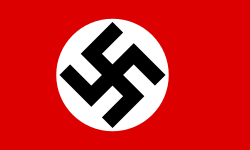| Flag | Date | Use | Description |
|---|
 | 800-888 | The Imperial Orilflamme of Charlemagne | A 3 pointed green field with 8 golden crosses and 6 flowers. |
 | 1214-1242 | Flag of The Duchy of Limburg | A Banner of arms of Limburg. It is made of a white field with a green stripe on the hoist and a red lion with yellow claws, teeth, tongue and crown over all. |
 | 1242-1443 | Flag of The County and Duchy of Luxemburg | A Banner of Arms of Luxembourg. It is made of ten horizontal white and blue stripes with a red lion with yellow claws, teeth, tongue and crown over all. |
 | 1443-1556 | Flag of The Duchy of Burgundy under Philip the Good | A Banner of The Coat of Arms of The Duchy of Burgundy under The House of Valois-Burgundy |
 | 1556-1684
1698-1700 | Flag of The Seventeen Provinces, The Southern Netherlands and The Spanish Netherlands | A red saltire resembling two crossed, roughly-pruned (knotted) branches, on a white field. |
 | 1556-1684
1698-1700 | Civil ensign of the Spanish Netherlands | A horizontal tricolour of red, white and yellow, with the Cross of Burgundy in the centre. |
 | 1684-1698
1701-1711
1814-1815 | Flag of The Kingdom of France | A White Field with several Fleur-de-lis. |
 | 1711-1713 | Flag of The Electorate of Bavaria | A Quartered Banner of Arms. the 1st and 4th quarters, An array of 21 lozenges of blue and white. the 2nd and 3rd quarters are the lion of The Electorate of Palatinate. plus an inescutcheon with a golden orb on a red field in the center. |
 | 1713-1795 | Flag of The Archduchy of Austria | three equal horizontal bands of red (top), white, and red. |
 | 1713-1740 | Flag of The Archduchy of Austria | A yellow field with a black double headed eagle with a crown on top and carrying the tricolored arms of Austria on his chest. |
 | 1781-1786 | Flag of The Austrian Netherlands | A tricolour, with three equal horizontal bands of red, white and gold with the arms of Austria. |
 | 1789-1790 | Flag of The Brabant Revolution | A tricolour, with three equal horizontal bands of red, black and yellow. |
 | 1795-1814 | Flag of The French First Republic and The First French Empire | A vertical tricolour of blue, white, and red (proportions 3:2). |
 | 1815-1830
1839-1848 | Flag of The United Kingdom of the Netherlands and The Kingdom of The Netherlands | A horizontal triband of red, white and blue. |
 | 1830-1831 | Flag of the Belgian Revolution | A tricolour, with three equal horizontal bands of black, yellow and red. |
 | 1831-1839 | Flag of The Kingdom of Belgium | A vertical tricolour of black, yellow, and red with a 2:3 ratio. |
 | 1848-1914
1918-1940
1944-1972 | Flag of Luxembourg | |
 | 1914-1918 | Flag of The German Empire used during the occupation of Luxembourg in World War I | A tricolour, made of three equal horizontal bands coloured black (top), white, and red (bottom). |
 | 1940-1945 | Flag of Nazi Germany used during the occupation of Luxembourg in World War II | A red field, with a white disc with a black swastika at a 45-degree angle. Disc and swastika are exactly in the centre. |





































